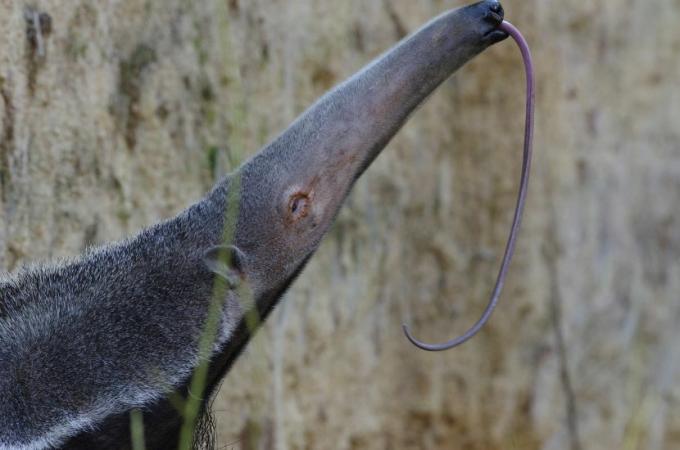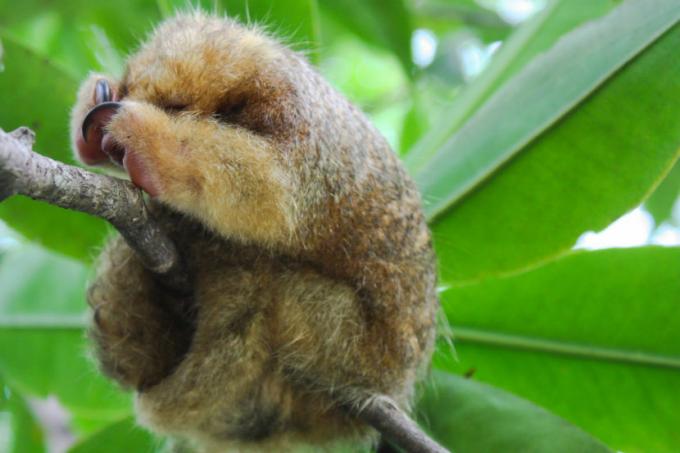Anteater is the name given to a group of animals vertebrates of the Mammalia class and that belong to the superorder Xenarthra, to the order Pilosa and are distributed in two families, the Cyclopedidae and Myrmecophagidae.
The animals belonging to the superorder Xenarthra are mainly distributed by the Central and South America. Currently, four species of anteaters are known, among which three are found in Brazil.
→ Anteater general characteristics

The anteater, as mentioned above, is an animal belonging to the Mammalia class and, thus, has some characteristics common to the others. mammals, but also features as well peculiar, as we will see below:
they are endothermics, but they have a low metabolic rate and their body temperature is around 34ºC;
they are solitary animals, that is, they do not live in groups;
have long hairs that help maintain body temperature;
they present synsacrum (fusion of the sacrum with some sacral and lumbar vertebrae);
have strong thoracic limbs and developed musculature;
have xinarthria (atypical joints in their vertebrae);
present ossified true (or external) ribs;
they usually feed on insects;
they do not have teeth, but they have a long tongue that helps them in feeding;
they have long and strong claws that help them in their search for food, in addition to having a defense function;
they have a long intestine, among other characteristics.
→ Anteater species in Brazil
Currently, four species of anteaters are known: the giant anteater (Myrmecophaga tridactyla), anteater (Anteater tetradactyla), anteater (didactylus cyclops) and the northern anteater (mexican anteater). Among these four, only the northern anteater is not present in Brazil. Next, we will highlight some characteristics of the species found in Brazil.

Giant Anteater (Myrmecophaga tridactyla)
Individuals belonging to this species are characterized by a dark gray coat, mixed with white and black. They are the biggest among the anteaters, can weigh about 40 kg and measure up to about 2 meters, so they are also known as giant anteaters.
Are found in regions of forests, savannas and open fields. In Brazil, it is found mainly in regions of thick. They feed exclusively on ants and termites.
Studies show that the giant anteater needs a large area to live, however, the size of the anteater's home range varies and depends on several factors such as availability and spatial distribution of food, habit, density of individuals, type of habitat, among others. factors.
Read too: Cerrado degradation
The giant anteater can change its habits, especially in the face of anthropic disturbances, in which case, its activities become more nocturnal. Regarding reproduction, females have one offspring per year and gestation time can reach 190 days. The puppies, when they are born, remain with the mother for about six months while they are breastfed.

Little Anteater (Anteater tetradactyla)
The little anteater is characterized by a golden and black coat. An interesting feature of the species is the no hair on the end of its tail. The young anteater usually lives on trees, coming down only to feed and do their necessities.
This species is about 77 cm and weighs 7 kg. The anteater inhabits regions of ftropical forests, savannas and even mangroves. They feed mainly on ants and termites, however, it has been observed feeding on honey. Regarding the reproductive aspect, like the other species of anteaters, the female has one offspring per year. The gestation time in this species is about 85 days.

Anteater (didactylus cyclops)
The tamanduaí is a kind of night habits and, like the little anteater, it lives on trees. It is the smallest among the anteaters, weighing just 300 grams and measuring about 55 cm. The anteater inhabits the tropical forests, gallery forests and mangroves.
Unlike other species, termites were not found in their diet analysis, as they feed only on ants. Regarding reproduction, females also have one offspring per year and their gestation time is around 160 days.

→ Preservation status of anteater species in Brazil
At actionsanthropic contribute to the decrease in the number of species across the planet. Thus, it is essential to monitor the most diverse populations for the development of preservation strategies.
In Brazil, currently, according to the Red List of Endangered Species of the International Union for the Conservation of Nature and Natural Resources (IUCN), anteater species are classified from the following way:
Giant Anteater (Myrmecophaga tridactyla): vulnerable
Little Anteater (Anteater tetradactyla): less worrying
Anteater (didactylus cyclops): less worrying
Read too: Endangered animals
Species classified as less of a concern indicate that their populations are not in danger. However, vulnerable species present risks of extinction. The giant anteater has shown a decline in its populations due to several factors, however, two are more worrying. As these species live in regions where there is a fire regime, such as the Cerrado, these animals end up being vulnerable to fire.
Habitat destruction, in particular, for the construction of roads without strategies to minimize impacts on wildlife is another serious problem, as this species becomes a constant victim of roadkill.


